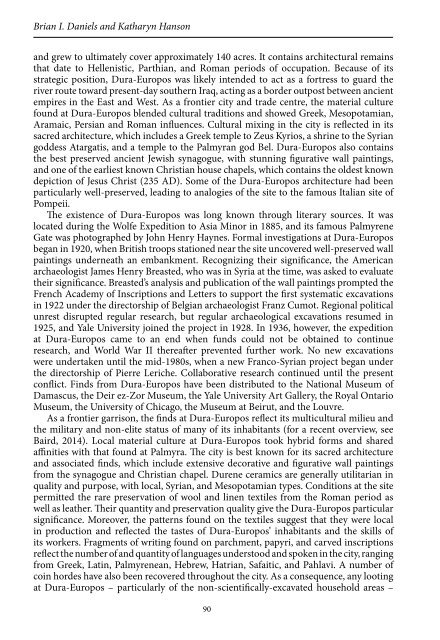Countering
Book_observatory_illicit_traffic_version%20issuu
Book_observatory_illicit_traffic_version%20issuu
You also want an ePaper? Increase the reach of your titles
YUMPU automatically turns print PDFs into web optimized ePapers that Google loves.
Archaeological Site Looting in Syria and Iraq<br />
may be intended to recover coin hordes and rare jewelry caches, which will destroy<br />
fragile textile fragments that may not have as ready a market.<br />
Geospatial analysis of satellite imagery shows that the site of Dura-Europos has<br />
been subjected to extremely heavy looting following the outset of Syria’s civil war<br />
(AAAS 2014b). The area inside the ancient city wall was so badly disrupted by April<br />
2014 that counting individual looting pits was not possible; pits overlapped to the extent<br />
that one could not be distinguished from another. Rather than assessing the pits in<br />
aggregate number, an assessment by the AAAS aimed to identify what areas had not been<br />
disrupted by looting – an approximate estimate given that areas ‘free’ of damage might<br />
be undermined by lateral tunnels or other destructive acts not otherwise visible from<br />
satellite imagery. The walled portion of Dura-Europos has been previously calculated to<br />
measure 50 hectares, and an area of 38 hectares has been thoroughly impacted by site<br />
looting. Some 76% of the walled-city is now disrupted by recent looting activity. Four<br />
vehicles were also observed inside the site in imagery from April 2014, suggesting that<br />
looting was ongoing at that time. Outside the city wall, satellite imagery analysis showed<br />
the density of looting to be lower but also severe. Based upon observed pit densities,<br />
the extent of the affected area, and counts of individual pits on the city’s outskirts, the<br />
AAAS (2014b) estimated the looting area beyond the city walls contain approximately<br />
3,750 individual looting pits. At least some of the looting outside the city walls predated<br />
the outbreak of the Syrian civil war (Casana 2015), but the majority of the pits show<br />
recent earth disturbance. The combined damage inside and outside the wall illustrates<br />
the nearly complete loss of this important ancient site.<br />
Conclusion<br />
Archaeological sites across Syria and Iraq have suffered from substantial looting in<br />
recent years, and many of the sites that comprise the famed ‘cradle of civilization’ are<br />
at significant risk. The scientific loss from looting is staggering, and there is increasing<br />
evidence that links the profit from this plunder to violence and criminal activity.<br />
Although the worst of the damage seems to occur around the time of active conflict,<br />
ongoing political instability places sites at continued risk for damage. Given the current<br />
realities on the ground in Syria and Iraq, it is nearly impossible to ground truth damage<br />
to archaeological sites in this region. High-resolution satellite imagery has been the<br />
primary research methodology employed to assess the extent of site looting. It remains<br />
to be seen what is left of these sites; test excavations have suggested that site pillage may<br />
not inevitably mean total site loss (Hanson 2012). Only careful future survey will be<br />
able to identify precisely how much has been lost. Even in the midst of conflict, there<br />
is some hope. There have been emergency on-the-ground interventions to protect key<br />
heritage sites in Syria, although these have been very difficult to undertake (Al Quntar et<br />
al. 2015). One can only hope political stability will return soon to the conflict areas and<br />
archaeological research with our Syrian and Iraqi colleagues can resume.<br />
References<br />
Adams, R. McC., and Nissen, H. 1972. The Uruk Countryside: The Natural Setting of<br />
Urban Societies (Chicago: University of Chicago Press).<br />
Adams, R. McC. 2008. ‘An Interdisciplinary Overview of a Mesopotamian City and its<br />
Hinterlands’. In Cuneiform Digital Journal 1, 25 March 2008. URL: < http://www.cdli.<br />
91


